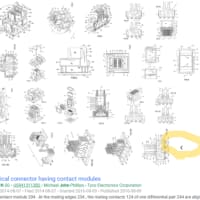US8041040(JP)
"Meanwhile, reflected sound gain control section 102 outputs to virtual reflected sound generating section 150 reflected sound gain control section output audio signal 194 controlled to be the sound pressure of the virtual reflected sound according to the distance when the sound is listened to with headphones. Based on reflected sound gain control section output audio signal 194, virtual reflected sound generating section 150 generates a virtual reflected sound by an acoustic characteristic filter of a given space and controls outside-head localization when the sound is listened to with headphones. "
「[0058] 一方、反射音ゲイン制御部102からは、ヘッドホン試聴時に距離に応じた仮想反射音の音圧に制御された反射音ゲイン制御部出力オーディオ信号194が、仮想反射音発生部150に出力される。仮想反射音発生部150では、反射音ゲイン制御部出力オーディオ信号194を基に、ある空間の音響特性フィルタによって仮想の反射音を発生し、ヘッドホン試聴時の頭外定位を制御する。 」
US2016345116
"[0006] Early headphone virtualizers applied a head-related transfer function (HRTF) to convey spatial information in binaural rendering. A HRTF is a set of direction- and distance-dependent filter pairs that characterize how sound transmits from a specific point in space (sound source location) to both ears of a listener in an anechoic environment. Essential spatial cues such as the interaural time difference (ITD), interaural level difference (ILD), head shadowing effect, spectral peaks and notches due to shoulder and pinna reflections, can be perceived in the rendered HRTF-filtered binaural content. Due to the constraint of human head size, the HRTFs do not provide sufficient or robust cues regarding source distance beyond roughly one meter. As a result, virtualizers based solely on a HRTF usually do not achieve good externalization or perceived distance. "
「[0003] 初期のヘッドフォン仮想化器は、バイノーラル・レンダリングにおける空間的情報を伝えるために頭部伝達関数(HRTF: head-related transfer function)を適用した。HRTFは、無響環境において空間内の特定の点(音源位置)から聴取者の両耳に音がどのように伝わるかを特徴付ける方向および距離依存のフィルタ対の集合である。両耳間時間差(ITD: interaural time difference)、両耳間レベル差(ILD: interaural level difference)、頭のシャドーイング効果(head shadowing effect)、肩および耳介反射に起因するスペクトルのピークおよびノッチといった本質的な空間的手がかりが、レンダリングされるHRTFフィルタリングされたバイノーラル・コンテンツにおいて知覚されることができる。人間の頭のサイズの制約条件のため、HRTFは、ほぼ1メートルより先の源距離に関しては十分または堅牢な手がかりを提供しない。結果として、HRTFのみに基づく仮想化器は通例、良好な頭外定位または知覚される距離を達成しない。 」
US2018035233
"[0005] However, a drawback of this approach is that physical room BRIRs can modify the signal to be rendered in undesired ways. When BRIRs are designed with adherence to the laws of room acoustics, some of the perceptual cues that lead to a sense of externalization, such as spectral combing and long T60 times, also cause side-effects such as sound coloration and time smearing. In fact, even top-quality listening rooms will impart some side-effects to the rendered output signal that are not desirable for headphone reproduction. Furthermore, the compelling listening experience that can be achieved during listening to binaural content in the actual measurement room is rarely achieved during listening to the same content in other environments (rooms)."
「[0005] しかしながら、このアプローチの欠点は、物理的な部屋BRIRが、レンダリングされるべき信号を、望まれない仕方で修正することがあるということである。BRIRが部屋音響の法則に従って設計されるとき、スペクトル・コーミング(spectral combing)および長いT60時間のような頭外定位の感覚につながる知覚的な手がかりのいくつかは、音の色づけ(sound coloration)および時間ぼかし(time smearing)のような副作用をも引き起こす。実のところ、最高品質の聴取室でさえ、ヘッドフォン再生のために望ましくないいくらかの副作用を、レンダリングされた出力信号に付与する。さらに、実際の測定室においてバイノーラル・コンテンツを聴いている間に達成できる説得力のある聴取経験が、他の環境(部屋)で同じコンテンツを聴いている間に達成されることはめったにない。 」
WO2007080225
"It is generally known that for headphones reproduction artificial spatialization can be performed by HRTF (Head Related Transfer Function) filtering, which produces binaural signals for the listener's left and right ear. Sound source signals are filtered with filters derived from the HRTFs corresponding to their direction of origin. A HRTF is the transfer function measured from a sound source in free field to the ear of a human or an artificial head, divided by the transfer function to a microphone replacing the head and placed in the middle of the head. Artificial room effect (e.g. early reflections and/or late reverberation) can be added to the spatialized signals to improve source externalization and naturalness."
「ヘッドフォンの再生に関し、リスナーの左耳および右耳用のバイノーラル信号を生成する頭部伝達関数(Head Related Transfer Function; HRTF)フィルタリングによって、人工的に空間化を行うことができることは一般的に知られている。音源信号は、その音源の方向に対応するHRTFから得られるフィルタでフィルタリングされる。HRTFは、自由音場における音源から人間の耳または人工の頭部まで測定される伝達関数であり、頭部と置換され、かつ頭部の中に配置されるマイクに対する伝達関数によって割られる。人工的室内効果(例えば、早期反射および/または後期残響)を空間化信号に加えることによって、音源の外在化(Externalization)および自然性(Naturalness)を改善できる。」
"According to an embodiment, in order to enhance the externalization, i.e. out-of-the-head localization, of the binaural signal, a moderate room response can be added to the binaural signal. For that purpose, the decoder may comprise a reverberation unit, located preferably between the summing units 316, 318 and the IFFT units 320, 322. The added room response imitates the effect of the room in a loudspeaker listening situation. The reverberation time needed is, however, short enough such that computational complexity is not remarkably increased."
「実施形態によっては、バイノーラル信号の外在化、つまり頭外定位を向上させるために、適度な室内応答をバイノーラル信号に加えることが可能である。そのために、復号器は、残響部を備えてもよい。この残響部は、加算部316、318とIFFT部320、322の間に位置することが好ましい。付加された室内応答は、スピーカリスニング状況における室内効果を模倣する。しかしながら、必要とされる残響時間は、計算複雑性が顕著に増加しないように十分短くする。」
WO2016046152
"[0002] A number of algorithms exist on the market for binaural playback of audio content over earphones. They are based on synthetic binaural room impulse responses (BRIR), which means they are based on generalized head-related transfer functions (HRTF) such as standard dummy heads or generalized functions from a large HRTF database. In addition, some algorithms allow users to select the most suitable BRIR from a given set of BRIRs. Such options can improve the listening quality; they include externalization and out-of-head localization, but individualization (for example, head shadowing, shoulder reflections or the pinna effect) is missing from the signal processing chain. Pinna information especially is as unique as a fingerprint. The addition of individualization by way of a personal BRIR can increase naturalness."
「イヤホーンを介して音声コンテンツをバイノーラル再生するための多くのアルゴリズムが、市場に存在する。それらのアルゴリズムは、合成バイノーラル室内インパルス応答(BRIR)に基づいており、それは、アルゴリズムが、大きい頭部伝達関数(HRTF)データベースの標準的なダミーヘッドまたは一般的な関数等、一般的なHRTFに基づいていることを意味する。さらに、一部のアルゴリズムは、BRIRの所与のセットから最も適切なBRIRをユーザが選択するのを可能にする。このようなオプションによって、リスニング品質を向上させることができる。このようなオプションは、外在化及び頭外定位を含むが、個別化(例えば、頭部シャドーイング、肩反射または耳介効果)は、信号処理チェーンから抜けている。特に、耳介情報は、指紋と同様、一意である。個人のBRIRによる個別化を追加することによって、自然さを向上させることができる。」


























※コメント投稿者のブログIDはブログ作成者のみに通知されます